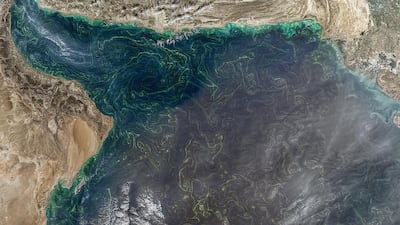Saadiyat Beach has been closed to swimmers after a harmful algal bloom was found in the sea surrounding the island.
It is understood that the red tide — which is caused when a species of algae called dinoflagellates grow out of control — was discovered at the weekend.
Dinoflagellates contain pigments that vary in colour from brown to red during the day — giving them their name — but they can appear luminescent at night — as happened in California last week when waves containing a red tide glowed as they broke on the shore off the coast of San Diego.
There are thousands of species of dinoflagellates — and a few dozen can be extremely toxic to people and marine life. In 2008 and 2009, a red tide caused serious damage to the UAE’s marine life, damaging fish stocks, coral, and wiping out large populations of fish in Dibba Rock. Shark numbers in the bay are only now recovering.
A spokesperson from Saadiyat Rotana Resort and Villas said the Tourism Development and Investment Authority had instructed the beach area be temporarily closed until the red tide cleared.
He said Environment Agency Abu Dhabi took samples of the red tide on Saadiyat at the weekend. Tests are ongoing to establish the exact type, but it is understood to be an irritant, rather than toxic.
Residents on Saadiyat received an email on Sunday saying that the beach has been closed for swimming until further notice.
“It is confirmed by EAD that the red algae are not toxic, however, can cause skin allergies. Further studies are still undergoing,” read the email.
“Therefore, you are kindly requested to abide strictly by the recommendation of the EAD and refrain from swimming in the sea. We will keep you posted as to when the beach will be safe for swimming.”
EAD and TDIC have both been contacted for a comment.
______________
Read more:
Red alert: Ministry monitors algal bloom in UAE's regional waters
Algal bloom the size of Mexico could threaten UAE marine life, experts say
Red tide not on the horizon, Fujairah fishermen say
______________
Marine biologists say phytoplankton species are always around, but certain conditions enhance their growth.
Red tides tend to occur more frequently as the temperature rises. And this combined with the current strong, dusty winds could be acting like a fertiliser, causing the algae to bloom, say scientists.
“If you have a lot of winds coming off the land it could be enhancing the amount of iron and allowing them to bloom,” said John Burt, Associate Professor of Biology at NYU Abu Dhabi.
“We have had winds for the past week coming off the land, so it is possible that we have this iron deposition going on that is enhancing things, along with the rising temperature. So when the winds turn around and start coming off of the sea again, we will see if it disappears or not. That would be a good indication of whether dust is involved.”
The Arabian Gulf is the hottest sea in the world, making it particularly susceptible to the phenomenon.
High concentrations of red tide have in the past clogged the filters of desalination plants in the UAE.
And in January the Ministry of Climate Change and Environment announced it was monitoring a red tide after receiving notice from Ras Al Khaimah Environmental Protection and Development Authority.
The bloom was detected in areas overlooking the west coast of the Arabian Gulf and the eastern coast of the Gulf of Oman.


